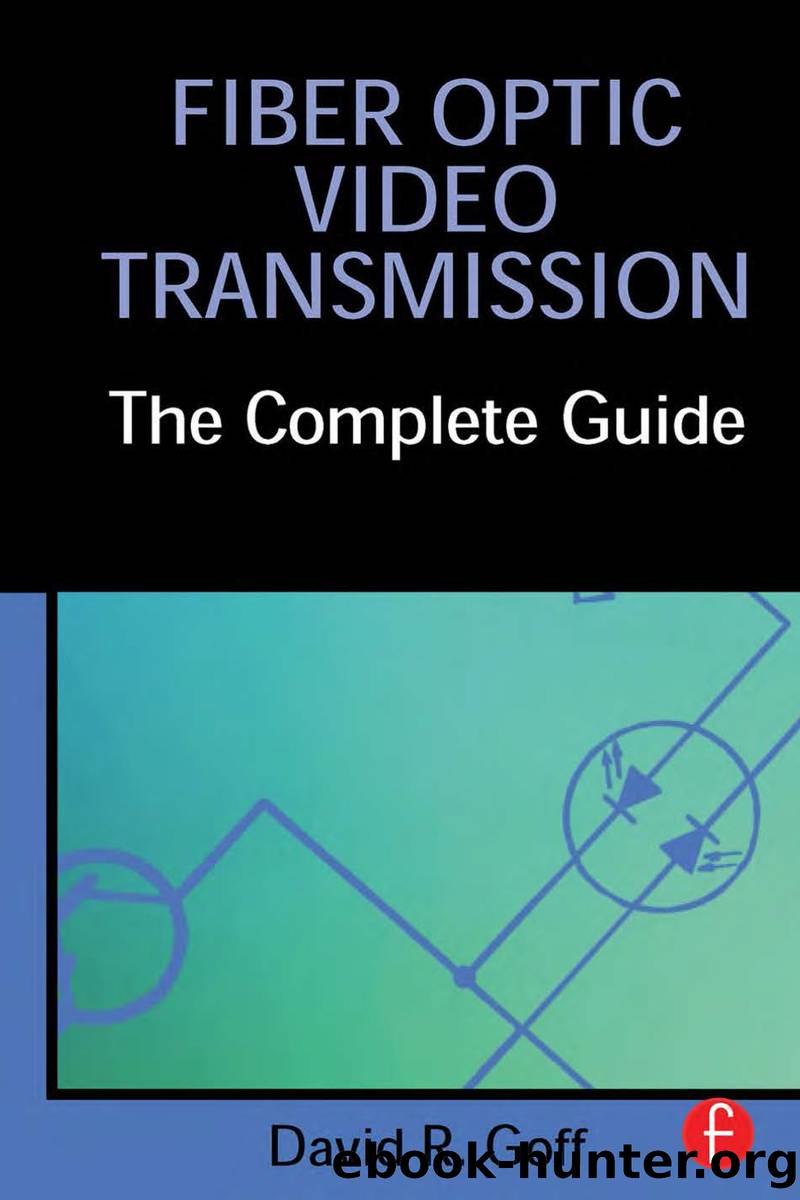Fiber Optic Video Transmission by Goff David;

Author:Goff, David; [Goff, David R.]
Language: eng
Format: epub
Publisher: Taylor & Francis Group
Published: 2022-04-23T00:00:00+00:00
Amplifier Noise Calculation
Noise figure, a commonly used and misunderstood parameter, adds to the confusion of understanding noise calculation in an amplifier. Consider an isolated amplifier such as the one illustrated in Figure 12.3.
Figure 12.3 Amplifier Noise Calculation As we know, the amplifier itself exhibits three main characteristics; gain (G), noise figure (NF), and bandwidth (BW). The input signal has a level SI and a signal-to-noise ratio SNRI. The amplifier noise figure (NF) can also determine the effective noise that is present at the input of the amplifier, PNI. Conversely, SNRO represents the signal-to-noise ratio at the output of the amplifier. It will always be less than SNRI due to the noise added by the amplifier. The output signal level is SO and the noise at the output of the amplifier due to the amplifier itself is PNO. PNO is PNI times the gain (G) of the amplifier.
Most texts indicate that the signal-to-noise ratio degrades by the noise figure (NF) when the signal goes through an amplifier. This misleading explanation conflicts with other formulae that show that the first amplifier in the chain as dominating SNR degradation. The noise figure tells us how much worse the amplifier noise is compared to a perfect Johnson noise source. A Johnson noise source can be thought of as an ideal resistor. Resistors generate noise because their atoms move in response to the ambient temperature. The equation for Johnson noise is:
Eq. 12.1
Where:
k = Boltzmann's Constant = 1.38Ã10-23 (J/K)
T = Temperature (K)
B = Bandwidth (Hz)
R = Resistance of the Noise Source (Ohms)
The power due to VNoise is PNoise (note the equation takes into account the maximum power transfer between equal impedances, thus the 4ã»R factor in the denominator):
Eq. 12.2
PNoise will have a value of -173.9 dBm at room temperature for a bandwidth of 1 Hz.
Noise in an amplifier or fiber optic link is often expressed in terms of noise figure NF (f). Other related terms are the noise factor (F) and noise temperature (TN). Noise factor F is related to noise figure f as follows:
Eq. 12.3
The noise temperature TN relates to the noise factor F as follows:
Eq. 12.4
Figure 12.4 shows the relationship between noise temperature, noise factor, and noise figure for noise figures from 0 dB to 6 dB. The equation for amplifier output noise due to the amplifier alone is:
Download
This site does not store any files on its server. We only index and link to content provided by other sites. Please contact the content providers to delete copyright contents if any and email us, we'll remove relevant links or contents immediately.
| Automotive | Engineering |
| Transportation |
Whiskies Galore by Ian Buxton(41524)
Introduction to Aircraft Design (Cambridge Aerospace Series) by John P. Fielding(32884)
Small Unmanned Fixed-wing Aircraft Design by Andrew J. Keane Andras Sobester James P. Scanlan & András Sóbester & James P. Scanlan(32569)
Craft Beer for the Homebrewer by Michael Agnew(17927)
Turbulence by E. J. Noyes(7693)
The Complete Stick Figure Physics Tutorials by Allen Sarah(7135)
Kaplan MCAT General Chemistry Review by Kaplan(6589)
The Thirst by Nesbo Jo(6432)
Bad Blood by John Carreyrou(6271)
Modelling of Convective Heat and Mass Transfer in Rotating Flows by Igor V. Shevchuk(6219)
Learning SQL by Alan Beaulieu(6029)
Weapons of Math Destruction by Cathy O'Neil(5823)
Man-made Catastrophes and Risk Information Concealment by Dmitry Chernov & Didier Sornette(5641)
Digital Minimalism by Cal Newport;(5388)
Life 3.0: Being Human in the Age of Artificial Intelligence by Tegmark Max(5182)
iGen by Jean M. Twenge(5156)
Secrets of Antigravity Propulsion: Tesla, UFOs, and Classified Aerospace Technology by Ph.D. Paul A. Laviolette(4974)
Design of Trajectory Optimization Approach for Space Maneuver Vehicle Skip Entry Problems by Runqi Chai & Al Savvaris & Antonios Tsourdos & Senchun Chai(4837)
Electronic Devices & Circuits by Jacob Millman & Christos C. Halkias(4741)
